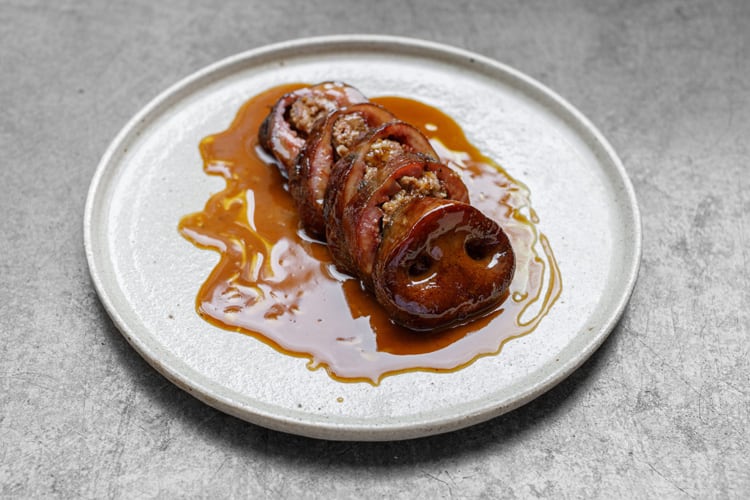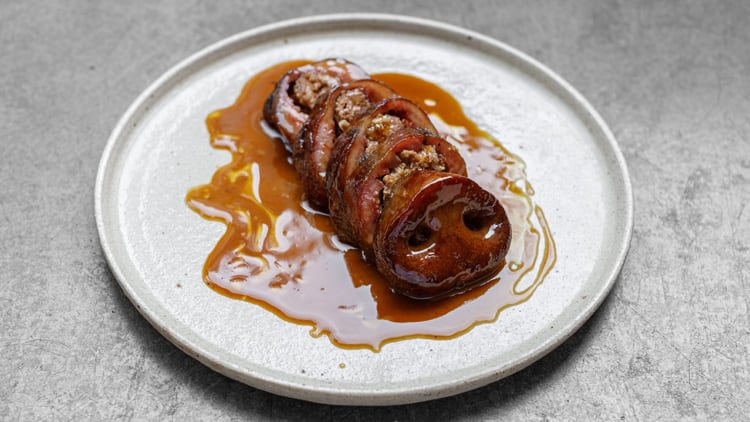On paper at least, Manteca is a difficult restaurant to define. Broadly, it’s modern Italian, with a menu that includes a range of salumi cured in house; a short selection of hand-rolled pastas; and for the mains, fire-cooked cuts of meat and fish to share. In terms of sourcing, it’s almost entirely British-focused, with executive chef Chris Leach working directly with farmers and suppliers across the UK, promoting a nose-to-tail ethos by only using whole animal carcasses. And then there’s the name; taken from a Spanish word that principally means pork fat or lard.
Even Leach struggles to conjure a succinct description when asked. “Sometimes I find it quite difficult to describe,” he says, frankly, amid a long pause. To ease the silence, I proffer ‘Britalian’, perhaps, as an apt descriptive; a portmanteau once used by Isaac McHale to describe his restaurant Luca in London’s Clerkenwell, which Manteca arguably shares some similarities with.
“I don’t know if I would use that term,” says Leach, slowly, turning it over in his head. “I see Manteca as a British restaurant cooking with Italian sensibilities. It’s very contemporary. You don’t really find restaurants like this in Italy.”
Having first established the Manteca concept during a four-month pop up at Mayfair-based residency restaurant 10 Heddon Street in the summer of 2019, Leach – who previously held roles at Kitty Fisher’s, Sager + Wilde, and Petersham Nurseries – went on to launch it as a restaurant on Great Marlborough Street in Soho later that year. Now, though, he is preparing to relocate to Shoreditch, securing a site on Curtain Road that he says will represent Manteca’s ‘first permanent restaurant’ space.
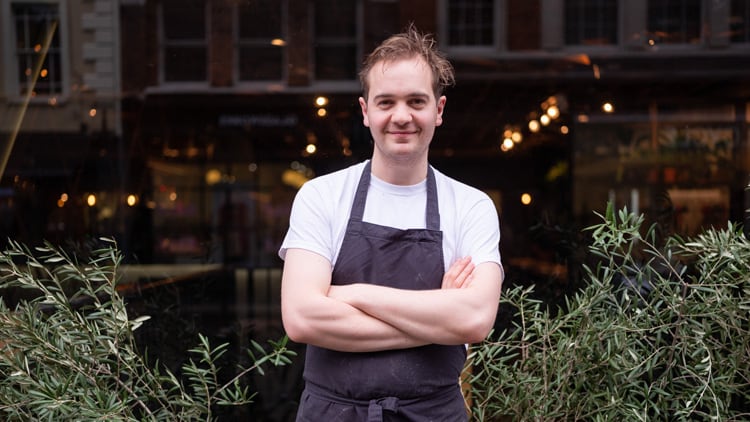
“We got the Soho site on a short lease, which was an amazing opportunity after the Mayfair residency,” he explains. “I was keen to capitalise on what I felt was a strong start at Heddon Street and build on that momentum. But I was always aware that eventually I’d have to look for something more permanent.
“It took a while to find somewhere. We looked at a lot of places, particularly around Borough and Soho. Then this place in Shoreditch came up and it made sense pretty quick. I could have opened it anywhere, but I’m glad it’s here.”
A ‘fully formed’ restaurant
We’re stood in the hollowed-out shell of the Curtain Road site, which previously housed a PizzaExpress. Around us a team of builders are working hard to get the restaurant ready for its mid-November opening. As we walk around the space, one of the workmen asks Leach to check over some newly delivered floor tiles; another is asking for his approval on a set of recently installed ceiling lights.
Even though the site is still some way off completion on the day I visit, Leach is able to paint a tangible image of how the restaurant will look. It’s a large space, split over two levels with 110 covers in total including a 20-seat terrace. The ground floor will feature an open kitchen and meat-slicing counter in the centre, with banquette and bar seating both available. Bifold windows will surround the space from three sides, with a wooden pasta bench at the front where chefs will be seen daily rolling and shaping sheets of homemade pasta. Downstairs, meanwhile, will be a new, glass-panelled hanging room for the restaurant's in-house butchery and salumi production.
“This will be Manteca, fully formed”
Designed by Box 9 architects, the soft, buttery yellow shades of the colour scheme will be complemented by blonde wood furniture that contrasts against the hard-wearing steel of the kitchen islands. In Leach’s own words it’ll be a ‘brighter and lighter’ than the dusky Soho site.
“This is what it was always supposed to be,” says Leach with an infectious zeal, as he shows me around. “We’ve built this space from the ground up, so we can make it in our image. I’ve always wanted to have a hanging room, but in Soho we never had the freedom or the room to do anything like that. Now we have it we can really start a full programme of whole animal butchery and meat curing.
“It’s a space where we can really develop our craft and expand on what we can offer on the menu. This will be Manteca, fully formed.”
A new Manteca menu
Whether or not Leach would describe Manteca as an Italian restaurant is somewhat moot. His inspirations openly come from the regional cooking styles he encountered when travelling through the country. “I love the food of Rome, particularly,” he says. “They have a really confident and robust approach to cooking there. And there’s Bologna, of course; a lot of the pastas we serve come from dishes I encountered there.”
Primarily, Leach draws from the food of northern Italy, with the Lombardy region also a key touchpoint. I ask again about his hesitancy to label Manteca as an Italian restaurant. “Italians are very respectful of tradition. I’m not Italian, and don’t feel quite so bound by tradition.
“For me, cooking Italian food just seems to be the best way of bringing together everything I’ve learned throughout my career.”
The move to Shoreditch will see Leach make several changes to the Manteca menu, with some dishes removed, and a number of new ones added. Many of the ‘signature’ plates will return, including the pig head fritti, now served with pilacca and pickled celery, rather than apple mostarda; ‘nduja-steamed mussels with cream, parsley and sourdough bread; duck liver parfait with black date jam and grilled bread; and the brown crab cacio e pepe.
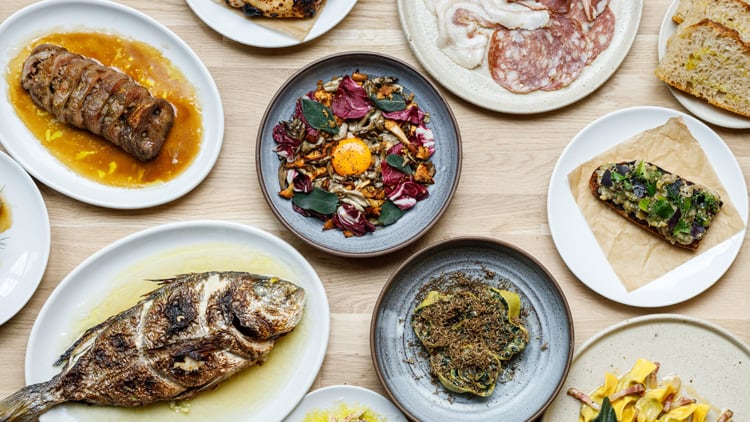
One notable absence, though, will be the pink fir potatoes with smoked cod’s roe, which has been a stalwart of the menu since the Heddon Street days. “I love that dish,” says Leach, when I enquire about its absence. “It’s really tasty, but we were buying the cod’s roe and just frying the potatoes. Sure, it was an easy win, but it didn’t feel like we were putting enough into it. And that’s something I really wanted to focus on in this new space.”
Much of the menu development for Shoreditch began long before the restaurant was signed for, with Leach and his team making the most of the extended downtime during the various Covid lockdowns. “There’s been a lot of stop and start, obviously, but I think having those periods have given us the room to make sure the restaurant is as good as it could be.
“We’ve had time to zone in on the menu and make sure we’ve got things absolutely right. Not just by refining the dishes, but also the concept; to hone in on what I want Manteca to be.”
A particular focus for Leach has been on developing dishes that utilise by-products from others. “I hate throwing things away,” he says. “Take the pasta scraps, for example, which are left over from rolling out the pasta dough. For ages I was looking for something to do with them. Initially I tried just frying them, which didn’t work. So, I spent a lot of time working out how we could turn them into something we could serve in the restaurant.”
The finished dish, which forms part of Manteca Shoreditch’s expanded snacks menu, sees the pasta scraps blanched, before being chilled, dehydrated, and finally fried. They’re then seasoned with a chilli and fennel salt.
“For me, cooking Italian food just seems to be the best way of bringing together everything I’ve learned throughout my career”
Another idea Leach has spent a long time trying to bring to fruition is a pig skin ragù starter. The skin is rendered down in the sauce, which is then topped with parmesan and served with a piece of crispy pig skin for dipping. Perhaps the most striking addition to the menu, though, is the stuffed pig snout, which will form part of a new changing line of specials that will also include house-made stracciatella with olive oil; zampone (stuffed trotter); and a chicken offal frittata.
“I am very proud of that one,” says Leach of the snout dish. “It took a lot of time to perfect as we could only test it when we had our next pig delivered. But it really works.” The snout is first brined, he explains, before being braised and then stuffed. After, it is wrapped in crépinette, roasted, and finally served with a rich pork sauce.
A lot of hanging around
Many of the new dishes feed into Leach’s whole animal philosophy, which is something he’s championed since his days cooking as sous chef at Tom Adams and Jamie Berger’s renowned barbecue restaurant Pitt Cue in Soho. “That’s where I first learnt about nose-to-tail cooking,” he says.
“The reason for buying whole animals is it allows us to work directly with the farmers and butchers. And as a cook it’s more engaging and exciting as it encourages us to be more imaginative.” Leach sources his meat from a small number of suppliers: Oxford Sandy and Black pigs come from Plumpton in Sussex; Herdwick cull ewes are sourced from Duchess Farms in Hertfordshire; ducks from Creedy Carver in Devon; and lamb from the Llanthony Valley, south-east Wales.
In terms of butchery, Leach follows Italian principles of using elongated and whole-muscle cuts, which is fundamental to his salumi production; a core element of the Manteca concept. When the restaurant first launched at Heddon Street, the only cured meat product on the menu was mortadella, made in-house to a recipe Leach developed during his time at Sager + Wilde.
The mortadella has become something of a signature on the Manteca menu, and will now feature at Shoreditch as an option on the dedicated salumeria menu; made possible thanks to the restaurant’s new subterranean hanging room. Guests will be able to choose from between 10 cured meats including ‘nduja crostino; fennel pollen salami; pancetta, served with artichoke crema and parmigianno; and a new wild boar mortadella. Each meat will be available to order separately, or as part of a sharing plate with focaccia, house pickles and olives.
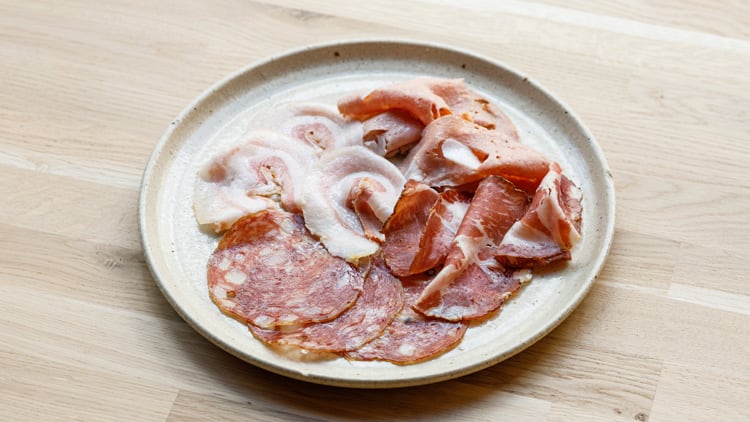
Like the mortadella, all of the salumi recipes have been worked on by Leach for some considerable time. “With the meats, I’m constantly tweaking the salt content, or the number of fennel seeds included in the mix, but the thing is it can take up to three months to see what the result it. It’s frustrating in a way, but it’s also something I love. There’s a patience to the craft that you have to learn and embrace.”
Leach notes that using whole carcasses helps with keeping the prices approachable. There’s certainly no shortage of modern, Italian-leaning restaurants in the capital. British chefs have been cooking great Italian food in London for decades, be it Ruth Rogers at The River Café; or Theo Randall at the InterContinental. Where Manteca differs significantly, however, is where it’s pitched – the strikingly affordable menu proving that cost doesn’t have to be a barrier to superior, chef-led dining.
While those who fancy a blowout meal are well catered for, a party of two could easily dine for around £30 to £40 per head, with drinks, and leave with both their bellies and their hearts full to bursting. Snacks and small plates start from as little as £2 and primarily sit between the £5 to £7 mark. Pastas are available as a substantial primo plate for £9 or £10, or as a slightly larger main for around £14. Bigger plates of meat and fish are, of course, more expensive, but by no means eyewatering, ranging primarily from £25 to £35.
“Price point was always key,” explains Leach. “It allows for a wider range of guests. I want people to be able to come in and have a light dinner after work; or come for a big anniversary meal.”
As already mentioned, the whole animal approach also encourages greater creativity; particularly when it comes to the larger, sharing dishes. “Obviously we only have a limited number of prime cuts, like steaks or chops; after that it’s about working out how to use the rest of the animal to create new dishes.”
As was the case at Soho, elements of the Shoreditch menu will change daily to reflect what’s in the kitchen. “That’s the exciting thing,” continues Leach. “It’s not that we’re always changing the menu, it’s working out what’s right based on what’s available. It’s a very collaborative process, and we always encourage junior chefs to come forward with ideas for dishes. It’s important to nurture that and give people that opportunity.”
Pasta but no pizza
Manteca operates under parent company DCL Hospitality, which Leach runs in partnership with David Carter, whose own restaurant, Smokestak, is located just a short walk away from the new Shoreditch site. Leach and Carter first met some years ago, and the Manteca concept is one they have worked on together from the start. Leach now leads the project, but Carter is still heavily involved in the operational side of the business.
So, what learnings has Leach carried forward from his experiences in Soho?
“With the lockdowns, we only had just over 12 months trade there in total. What we learnt is we could do the dishes we wanted, at volume. And we can do that here, but more effectively. The larger space is a practical benefit; it means we can have two pasta boilers, rather than one; and we’ve also been able to install a wood oven, which we could never have before.”
“I think this place is going to be really special”
The wood oven will see the addition of flatbreads, as well as some baked pasta dishes. But what about pizza? “Definitely not,” replies Leach, almost immediately. “I love pizza, but if we put it on the menu then immediately we’d be a pizza restaurant. And I don’t want to do something like that; it would just be to the detriment of the rest of the menu.”
Originally, when the plans for the Shoreditch site first surfaced, it was assumed that it would operate in tandem with the Soho restaurant. But for Leach, the restaurant’s craft-led approach means he has no intention to open a second site under the brand. “There’s only ever going to be one Manteca,” he says. He pauses again and takes another look around the bustling space. “I think this place is going to be really special.”

